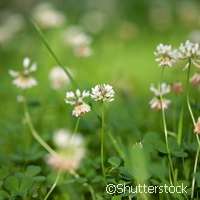The more, the merrier: Mixing plant species for benefits

Researchers believe that the richness of plant species can boost primary production. But studies investigating the mechanisms behind positive plant biomass response to greater plant diversity have been lacking - until now. A team of scientists in the Netherlands and the United Kingdom examined how mixed cropping benefits plants and their neighbours, boosting both their quality and weight. Their findings, presented in the journal PLoS ONE, show how carbon and nitrogen are higher in plant mixtures.
The fixation of atmospheric nitrogen by clover helps neighbouring plants, but clover also gets key support. Researchers from Wageningen University in the Netherlands and the Lancaster Environment Centre, Lancaster University in the United Kingdom discovered that clover plants and grasses have the capacity to transport carbon into the ground more quickly and generate more higher-grade biomass when plant species grow close to each other instead of being surrounded by plants of the same species.
According to the researchers, clover species live in areas that contain root-inhabiting bacteria that remove nitrogen from their air and provide it to the plants. But the advantage is not given solely to clover species; non-nitrogen-fixing neighbouring plants also get a boost because nitrogen in clover enters the soil, triggered by the leakage from the roots and the breakdown of dead roots.
This study demonstrated that 'love' exists between plants that fix nitrogen and those that do not. So plant species work together to deliver a higher yield in mixed crops.
White clover in particular can quickly transport the carbon it had absorbed during the day to plant parts found under the ground. However, the team observed that this occurred only if they grew close to other plant species. In such conditions, the transport was three times faster, and sweet vernal grass in a mixed culture also incorporated and transported carbon more quickly.
'We found that all plant species, with the exception of Lolium perenne, yielded more when grown in a six-species mixture, but Trifolium repens and Anthoxanthum odoratum benefitted most,' the authors write. 'For these two plant species, we also found that the 13C tracer enrichment in leaves and its translocation over time was higher in plant individuals grown in six-species mixture as opposed to when grown in monoculture.'
The results showed that the nitrogen content was considerably higher in all non-nitrogen-fixing plant species, but it remained steady in the clover plants. The lower carbon/nitrogen proportion shrank from 28 to 22 in the non-nitrogen-fixing plant species. The team found that more nitrogen per unit of carbon was found in the harvestable material originating from mixed crops.
The researchers noted that more studies should be carried out to determine how the underlying processes work.
More information: De Deyn, G. et al., 'Increased plant carbon translocation linked to overyielding in grassland species mixtures', PLoS ONE, published online 25 September 2012. www.plosone.org/home.action
Journal information: PLoS ONE
Provided by CORDIS













